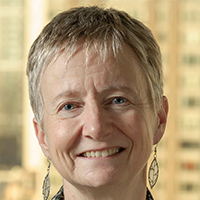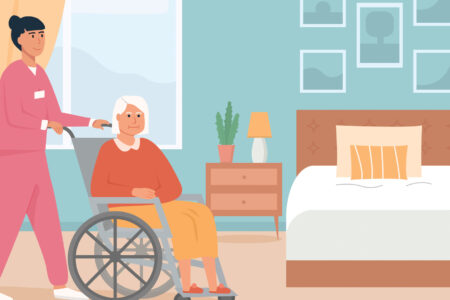
Implanting a defective device or prescribing the wrong medication are two examples of medical errors causing death and ravaging lives. Doing the wrong thing to someone is vastly more noticeable than failing to provide an available therapy, but omission error causes significant harm to the individual and to those who witness their suffering.
When a person with a failing organ, stroke or other chronic life-limiting disease has persistent suffering that goes untreated, they can become depressed and hopeless. It’s a common pathway to severe distress that can lead people to request Medical Assistance in Dying (MAiD).
This is a medical error.
The error is not in receiving MAiD, as the person may meet all the requirements: unbearable suffering, a grievous and permanent condition, an advanced state of decline, ability to give informed and voluntary consent. The error occurred in the months before, when the pain, shortness of breath, anxiety, feeling a burden to others began, but was not recognized and treated. Because there is no single event or “fail,” the slide into despair is gradual.
For example, people with advanced and severe heart or lung disease might be receiving multiple medications to help their heart function but still get breathless with minimal physical effort. To cope with the scary feeling of breathlessness, they do less and less and gradually become depressed because they are home-bound and feel useless. Most chronic illness clinics rely on clinicians – doctors, registered nurses, nurse-practitioners – to identify and treat symptoms and help people cope with illness, but this requires time and knowledge of palliative care, which they may not have. Opioid medication relieves shortness of breath, but physicians are very reluctant to prescribe opioids because of the opioid crisis and fear of causing harm. For multiple reasons, pain and shortness of breath in advanced illness are often inadequately treated. The concept of untreated suffering as a medical error is something I have written about before in an open-access peer-reviewed journal.
Good quality palliative care provides escalating therapy for symptoms that do not respond to basic treatment. If the needs are complex, it may involve multiple team members or specialists. In all situations, a meeting with the team, the individual and their identified family ensures everyone is understanding what is happening. This kind of care has been shown to reduce symptoms of depression, improve the quality of life, and sometimes lengthens life. The earlier the intervention the better the prevention of suffering, distress and despair. This care should be part of all chronic disease therapy, but currently is considered an extra therapy often sought only in the last weeks of life.
Health Canada regulated MAiD data collection in 2018 and published its first report – Medical Assistance in Dying in Canada 2019 – in July 2020. In it, the MAiD provider was compelled to indicate whether the patient had received palliative care and how soon it had begun before life termination: one month or more, two weeks to one month, or less than two weeks. The report highlights that 82 percent of the 5,389 people who received MAiD had palliative services. On closer scrutiny it is evident that 854 Canadians had access to palliative care for less than two weeks prior to life termination, so the trigger for a referral to palliative care was likely the request for MAiD.
This should be considered a failure of our system. Many of these people may have been suffering for months without access to quality palliative care.
The report also says 874 people (16.2 percent) received no palliative care despite it being available to 89.6 percent of this group, according to the MAiD provider. It is unlikely that they all refused it. Did they have a condition that their doctor did not recognize as benefiting from palliative care (chronic pain secondary to disease or disability)? Even if we consider just the 91 patients (10.4 percent) who had no offer of palliative care, that is significant. If advocates came to the media with 91 people who qualified for MAiD but who were unable to access it in 2019, I believe our government would take action. Sadly, this report does not indicate any plan to improve palliative care access but concludes with the ambiguous statement “requests for MAiD are not necessarily being driven by a lack of access to palliative care.”
By any professional, industrial, or business standards this is not acceptable, and there is need for an urgent review of these cases (and the unknowns) to determine how many are medical errors.
My analysis of the report is that 91 patients had absolutely no access to palliative care and 854 received palliative care only after they were experiencing a depth of suffering and despair that led them to request an end to their life. In the case of another 93 patients, it is not known whether or not they received palliative care. This makes a total of 945 people (plus some of the 93 unknown) who failed to receive adequate palliative care. Of the 5,389 Canadians who received MAiD in 2019, this makes a potential medical error rate of 17.5 percent. By any professional, industrial, or business standards this is not acceptable, and there is need for an urgent review of these cases (and the unknowns) to determine how many are medical errors.
The federal government will revise the criteria for MAiD this year, removing the requirement that death must be reasonably foreseeable. Since this will open up life termination to those who are not traditionally recognized as needing palliative care (it is a common misconception that palliative care is only for the dying), we may see even more people requesting life termination from the very health care system that failed to provide earlier interventions that should be readily available.
Canada needs to introduce palliative care standards in all health-care settings for patients with chronic illness or disability. This would mandate the screening for physical and psychological symptoms and distress throughout the disease trajectory. The standards would ensure that providers develop effective processes to manage these symptoms and prevent suffering. Part of the standards process would require the ability for in-home telemedicine throughout Canada so that people in rural and remote areas are not underserved as they are now.
Many more people will suffer and may die poorly – but naturally – driving more Canadians to favour MAiD as they do not see alternatives to suffering. Along with system changes, all chronic disease and disability providers need to take personal responsibility for identifying symptoms and distress as well as seeking early and effective interventions for their patients. Substantial changes must be made to the provision of palliative care across this country. Otherwise our healthcare system continues to fail individuals when they most need help, whether they die naturally or by MAiD.
Photo: Shutterstock,com, by Guschenkova.









